How 1950s Dresses Redefined Style: Flattering Waistlines, Vibrant Hues, and Timeless Elegance
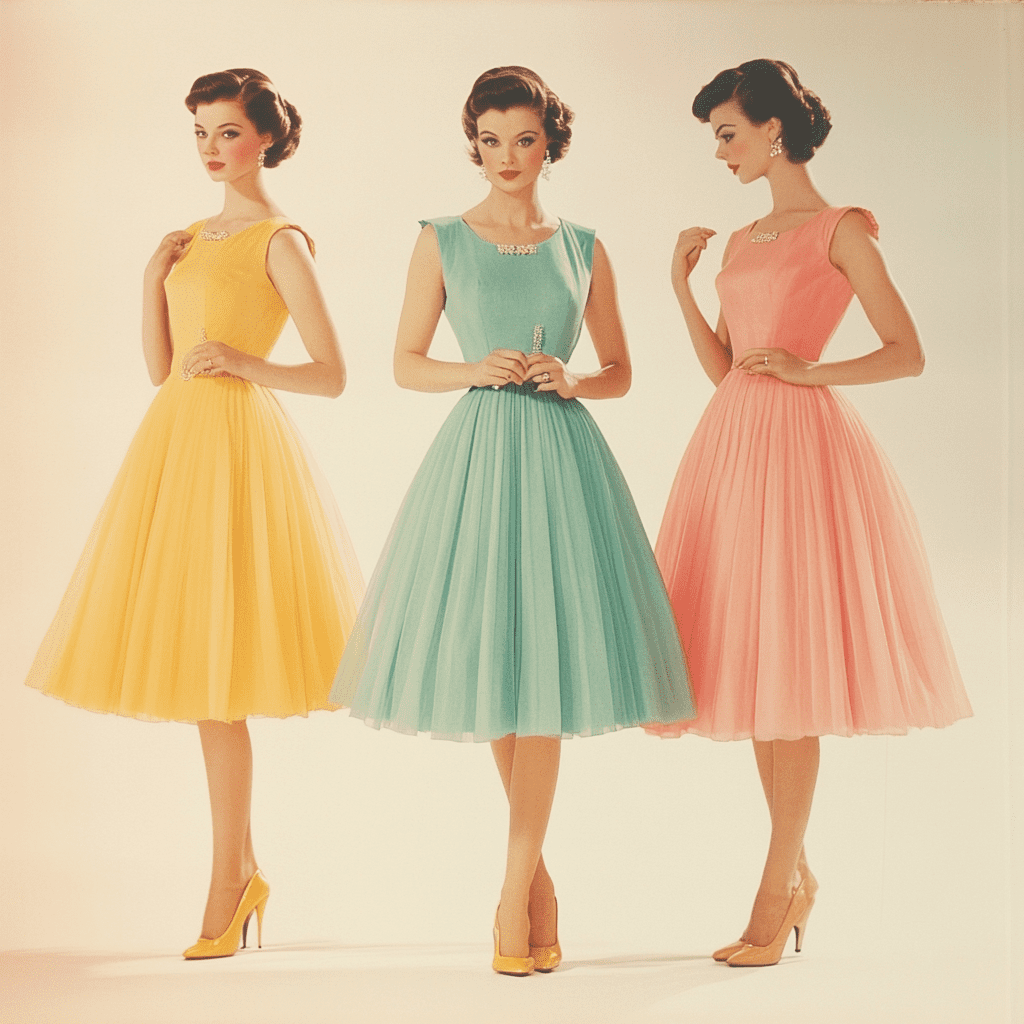
In the 1950s, fashion was all about presenting a neat and tidy image. Dresses that hugged the waist but flared loosely at the hips and thighs were a common fashion choice for women. Dresses like these were commonly made from breathable materials like cotton, linen, and silk, making them ideal for warmer months. Many women also opted for dresses in vivid hues like pink, blue, and green.
The Glamorous Rise of 1950s Cocktail Dresses: Luxurious Fabrics, Elegant Details, and Timeless Formal Gowns
The 1950s also saw the rise of the cocktail dress and the formal gown. These dresses were typically made from expensive materials like silk or satin and adorned with rhinestones, pearls, or lace. They were designed to be worn to formal occasions and were often paired with heels and a clutch.
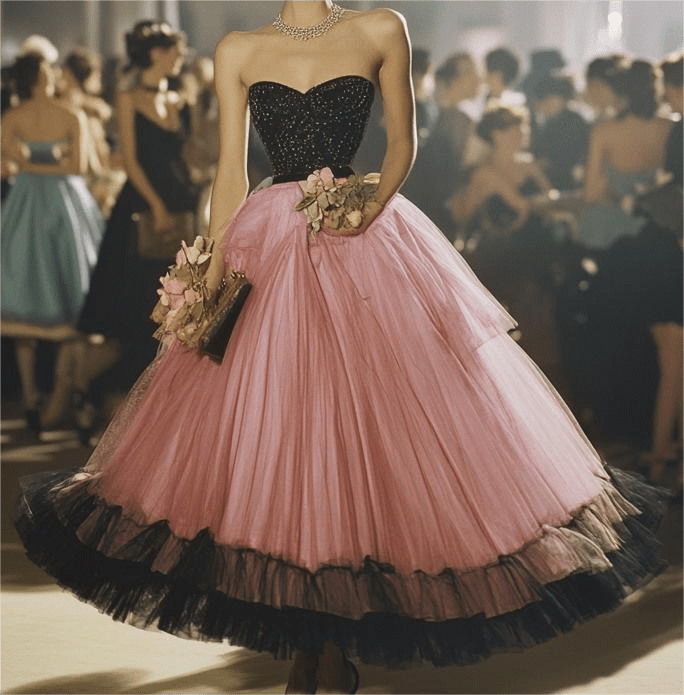
The 1950s Crinoline Skirt: A Staple of Vintage Fashion, Amplifying Curves and Silhouettes with Grace
Another staple of the era’s fashion was the crinoline skirt. These skirts were typically worn beneath dresses in order to amplify their silhouette. They were worn to emphasise a woman’s curves and were crafted from a lightweight, rigid material.

The Feminine Flourish: Exploring 1950s Dress Silhouettes and Their Evolution
Dresses in the 1950s had a more natural and less constrictive silhouette than those of the 1940s, thanks to a more defined waistline, a full skirt, and a fitted bodice. Clothing was rationed during the 1940s, a decade heavily influenced by the Second World War, and as a result, styles became more practical and less flashy. Dresses in the 1960s featured looser cuts, brighter prints, and new synthetic fabrics; they were aimed squarely at the youth market.
Dresses of the 1950s were characterised by full, flared skirts that were often paired with fitted tops to create a figure-hugging effect. The A-line dress, the full-skirted dress, and the sheath dress were all extremely fashionable options for women in the 1950s. The skirt of the A-line dress flared out from the waist and paired with a fitted bodice. The flared skirt of the full-skirted dress typically reached the wearer’s ankles. The sheath dress was a type of bodycon dress that was worn to accentuate a woman’s curves and create a striking profile.
Comfort and Style: How 1950s Casual Dresses Offered Effortless Elegance for Everyday Errands and Socializing

Dresses worn for casual occasions were typically made of airy materials like cotton and linen, and had a looser cut for greater comfort. Regular use included errands and socialising with friends.
Elegant Cocktail Dresses and Glamorous Prom Gowns: The Extravagant Fashion of 1950s Formal Events
Cocktail dresses, in contrast, were more formal and frequently crafted from silk or satin. They were made with the intention of being worn to fancy events and parties.
Dresses worn to proms and other formal dances resembled cocktail dresses but were created with more formal occasions in mind. They were typically crafted from expensive materials like silk and satin and adorned with rhinestones, beads, and lace.
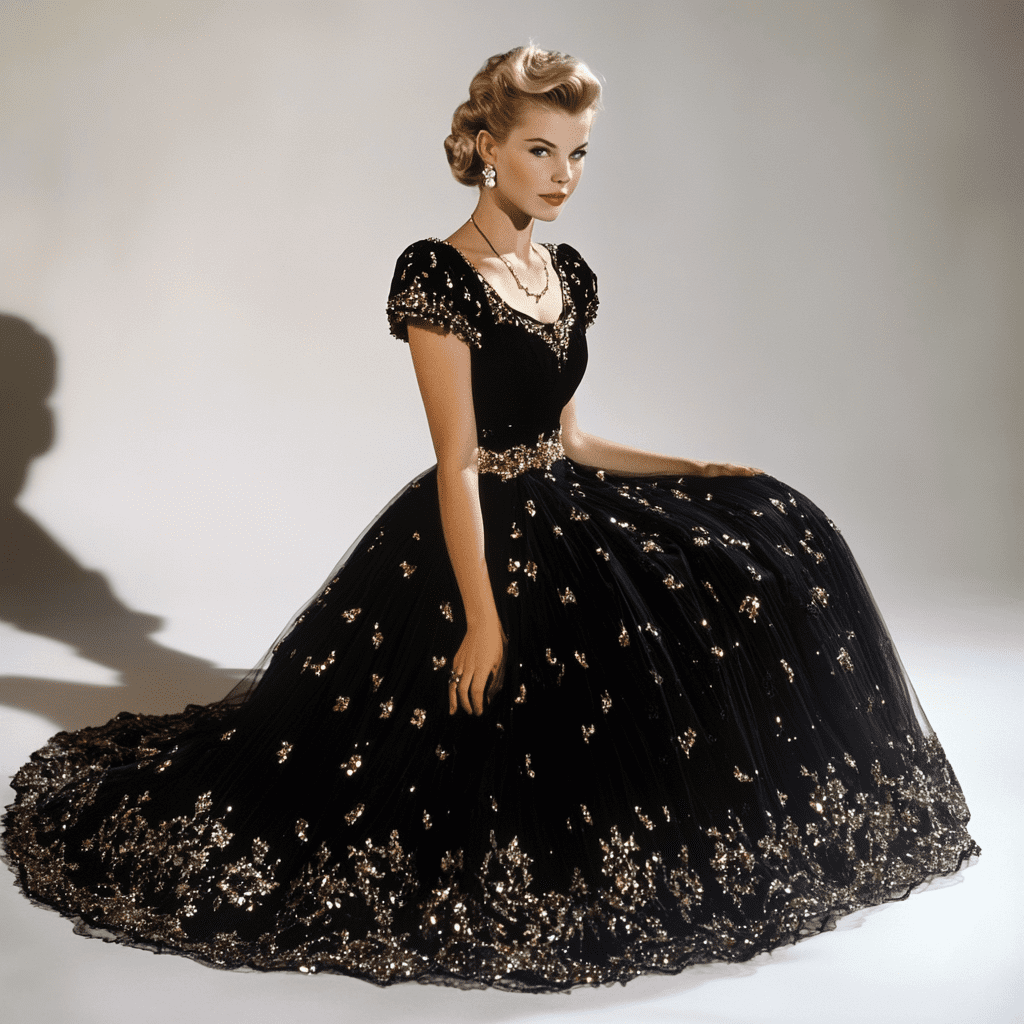
The Defining Dress Silhouettes That Shaped 1950s Fashion
The 1950s saw a proliferation of dress silhouettes. Important ones include:
The A-line dress was characterised by a tight bodice and a skirt that flared out from the hips, creating the letter “A” silhouette. This look was well-liked because it could be worn by anyone and looked good in any setting.
The full-skirted dress was characterised by a flared skirt that dipped to the floor. The full-skirted dress was a favourite because it emphasised the wearer’s femininity and fullness.
The sheath dress was a figure-hugging style that was commonly worn to emphasise a more alluring and feminine profile. Women with hourglass figures favoured this style, and it was frequently seen at black-tie events.
The shift dress was a form of simple, straight-cut dress that flowed from the shoulders to the floor without an obvious waist. Women who favoured a looser, more comfortable fit wore this style frequently.
The pencil skirt dress was characterised by a close-fitting bodice and a knee-length skirt that flared out sharply at the hem. Women who wanted to appear more refined frequently wore this.
Many dresses from the 1950s had sophisticated details like pleats, ruffles, lace, and embroidery. The addition of bows, sashes, and other embellishments to some dresses further elevated their already sophisticated style. Dresses featured a wide variety of sleeve lengths, widths, and shapes, from cap sleeves and short sleeves to long sleeves and puff sleeves, and even off-the-shoulder sleeves.
The colours of the dresses of the 1950s were also a major design element, with many dresses featuring both bright and bold hues like pink, blue, and green, and more subdued tones like grey, navy, and beige. Dresses also came in a variety of prints, including florals, stripes, and polka dots.
Iconic Polka Dot Dresses of the 1950s: From Bold to Feminine Styles That Shaped Fashion History

In the 1950s, polka dot dresses were a popular fashion choice, adored for their timeless charm and versatile patterns. These dresses came in a variety of colors and styles, allowing women to express their personality through their wardrobe. One of the most iconic versions was the red and white polka dot dress, which became a signature look during this era. The vibrant red contrasted against the white background, creating a playful yet sophisticated appearance that was often worn for casual outings and summer events.
Black and white polka dot dresses were another staple of 1950s fashion, offering a more elegant and formal option. These dresses were perfect for evening events or more refined gatherings, providing a look that was both classic and timeless. The black and white combination symbolized sophistication, and women of all ages embraced this style for its versatility and grace.
In addition to these classic color schemes, pastel polka dot dresses were immensely popular, particularly in shades of pink, blue, and yellow. These softer hues were often chosen for more feminine, girlish looks, adding a touch of delicacy and charm to a woman’s wardrobe. These dresses were perfect for day-to-day wear, especially for social gatherings, lunch dates, or casual errands.

More daring fashionistas in the 1950s gravitated towards bright polka dot dresses in colors like green, purple, and orange. These vibrant shades were especially favored by younger women who wanted to make a bold statement. These dresses offered a fun and lively alternative to the more traditional color palettes, making them a standout choice for summer parties or casual outings.
Another playful take on the polka dot trend in the 1950s was the rainbow polka dot dress. These dresses featured an array of vibrant colors, from pinks to blues to yellows, all in one garment. The multi-colored polka dots made for a whimsical and eye-catching look, perfect for those wanting to stand out in a crowd.
Navy blue and white polka dot dresses also had their place in the 1950s dress repertoire, providing a more understated but still fashionable option. Navy blue was a popular color in the post-war era for its refined and mature feel. When paired with white polka dots, it created a look that was both stylish and polished, often worn for semi-formal events or everyday elegance.
Polka dots were a favorite among 1950s designers and were embraced by women of all ages because they were easy to style and universally flattering. The playful print could be dressed up or down depending on the occasion, making it a versatile choice in a woman’s wardrobe. Whether in bold colors or classic black and white, polka dot dresses were a staple of 1950s fashion, reflecting the fun, femininity, and elegance of the era.
In the world of 1950s dresses, polka dots not only added a splash of color but also symbolized the era’s love for patterns and prints, making them a timeless choice that still influences fashion today.
Vibrant Floral Prints: A Staple in 1950s Dress Fashion
Dresses with floral prints were also common in the 1950s. In the 1950s, floral prints tended to be large, vivid, and eye-catching. Dresses with floral prints and the following colours were especially popular in the ’50s.
Floral prints in bright and bold colours like red, pink, yellow, and purple were all the rage in the 1950s. These patterns were frequently used to achieve a carefree and youthful appearance.
Floral prints in gentle pastels like pink, blue, and yellow were also common in the 1950s. These patterns were commonly used to convey a more delicate and girly vibe.
More muted colours were used in some 1950s floral prints, such as green, blue, and brown, for a more refined and elegant look.
Huge, oversized flowers and leaves were typical of floral prints from the ’50s. As a result, the overall appearance was more dramatic and captivating.
Many of the dresses had floral patterns reminiscent of the 1940s and 1950s, with motifs like roses, poppies, and daisies. This type of print was frequently used to achieve a more traditional appearance.
Some 1950s floral prints featured a mash-up of colours and patterns for a more carefree and fun vibe.
Not only were dresses adorned with floral prints, but so were blouses, skirts, hats, and other headwear and accessories. Floral prints were well-liked by people of all ages and were seen as adaptable and appropriate for a wide range of settings, from the everyday to the formal.
Striking Geometric Prints: A Bold Fashion Trend in 1950s Dresses

Dresses featuring geometric prints were also widely worn during the ’50s. In the 1950s, geometric prints became increasingly popular and were often seen as a symbol of modernity due to their vivid colours and striking designs. Dresses in the following geometric prints and colours were particularly popular in the ’50s:
Vibrant and flamboyant: The 1950s saw a surge in the popularity of geometric prints in a wide range of bright and flamboyant colours. These patterns were frequently used to achieve a carefree and youthful appearance.
Black and white: Geometric prints in black and white were also common in the 1950s. These patterns were used to achieve a more refined and stylish appearance; they never went out of style.
Soft, pastel tones like pink, blue, and yellow were used in some 1950s geometric prints for a more refined and girly vibe.
Color combination: Some 1950s geometric prints used a combination of colours to create a more carefree and joyful vibe.
Many popular geometric prints of the ’50s featured oversized shapes and daring patterns. As a result, the overall appearance was more dramatic and captivating.
All ages and genders alike showed a fondness for geometric prints due to their adaptability and wide range of potential uses.
Timeless Stripes: The Most Iconic Color Combinations for 1950s Dresses
Dresses with horizontal stripes were also very popular in the 1950s. They said that a striped pattern was always appropriate and would never go out of style. In the 1950s, these were the most frequently seen striped colour schemes:
In the 1950s, striped dresses in black and white were a common fashion choice. The sharp contrast between the black and white stripes made for an elegant appearance.
The 1950s saw a resurgence in the popularity of red and white as a complementary colour scheme; the era’s signature red and white striped looks were especially popular.
For a more demure and traditional look, many fashionable women opted for blue and white.
For a more delicate and feminine look, some 1950s striped dresses opted for pastel colours like pink, blue, and yellow.
Fashionable striped dresses of the ’50s often came in bright hues like orange, green, and purple, which gave the wearer a confident and even a bit cheeky air.
It’s important to note that striped dresses came in a wide variety of colour combinations; some even had stripes of varying intensities of the same colour. Women of all ages felt comfortable in striped dresses because of their adaptability and the fact that they could be worn to a variety of events.
Popular Dress Lengths of the 1950s: From Tea-Length to Maxi Styles
Dresses in the 1950s came in a wide range of lengths that were determined by factors like fashion and formality. These were the most sought after sizes:
Popular for both business and pleasure, the tea length hits right above the ankle. Elegant and appropriate for special occasions like weddings and parties, tea-length dresses were all the rage.
This length, which ends slightly above the knee, is appropriate for both everyday and semi-formal wear. Knee-length dresses were considered adaptable and could be worn anywhere from the office to a day out in the sun or even a formal event.
The knee is covered by a midi-length dress, which was a common style in the 1950s. Dresses that stopped at the knee were the height of sophistication and grace at proms, cocktail parties, and weddings.
This length, which ends just above the ankle, was very fashionable in the latter half of the ’50s and throughout the ’60s. The beach and summertime were ideal settings for the loose, flowing silhouettes of maxi dresses.
It’s important to note that the knee-length dress was the most widely worn length in the 1950s. The reasons for this include the fact that it was deemed a ladylike length, could be worn in a variety of situations, and was easy to move in. Furthermore, it worked for ladies of all ages.
Timeless Sleeve Styles of 1950s Dresses: From Cap Sleeves to Long Elegance
Dresses for women in the 1950s featured a wide variety of sleeve lengths and shapes, depending on the season and occasion. The most widely worn sleeve styles included:
Sleeves that ended at the cap of the shoulder were called “cap sleeves,” and they were worn for both casual and formal occasions.
Dresses without sleeves were all the rage in the 1950s, especially during the warmest months of the year. They were ideal for warm weather and were paired with a cardigan or jacket when it got cold.
Sleeves that ended just above the elbow were a common sight at casual and semi-formal events alike. They could be worn to the office, during the day, or even to a party without looking out of place.
Also common in the 1950s were three-quarter sleeves, which ended at the wearer’s elbow. They were commonly paired with a cardigan or jacket for colder weather and were admired for their adaptability and versatility.
In the 1950s, especially during the colder months, people favoured wearing their sleeves all the way down to their wrists. They were viewed as sophisticated and appropriate for events like proms, cocktail parties, and weddings.
It’s worth noting that in the 1950s, short sleeves were the most popular choice for dresses due to their convenience, mobility, and adaptability. Furthermore, they were ideal for ladies of any age.
Exploring the Fashion Variations of 1950s Dresses: From Jumper Dresses to the New Look
Younger women of the 1950s often wore jumper dresses, also called pinafores. The fact that they could be dressed up or down made them a practical and adaptable option. Jumper dresses were popular in the 1950s and 1960s and were characterised by a close-fitting bodice and a flared skirt.
There was a great deal of variety in 1950s fashion, particularly in terms of cut and style. Full skirts, defined waists, and a generally feminine silhouette were hallmarks of the New Look, made popular by designer Christian Dior. This look was hugely popular across the Atlantic. In Britain, subcultures like “teddy boy” and “rockabilly” popularised a more masculine, countercultural style, complete with skinny suits and leather jackets.
The “sack” dress, with its straight, boxy silhouette, and the “sheath” dress, with its close-fitting, simple style, were also prominent in the 1950s fashion scene alongside the New Look.
Dresses with a full or circle skirt or a swing silhouette were popular choices because they allowed for free movement while dancing.
J.C. Penney, Sears, and Montgomery Ward were some of the most well-known and reasonably priced dress retailers in the 1950s. Dresses were a popular purchase, and many shoppers visited both mass retailers and boutiques. Dresses could be purchased off the rack, but some people also went to tailors or made their own.
The 1950 Dress – Influential Designers
There were a plethora of new designers making their mark in the 1950s, an era of tremendous upheaval in the fashion industry. The 1950s saw the rise of many talented designers, including:
A French fashion designer, Christian Dior is best known for introducing the “New Look” in the 1950s. The hourglass figure was achieved by the New Look’s full skirt, waist cinching, and hip padding. This look was well-liked by the ladies because of its sophisticated femininity.
French fashion designer Coco Chanel is revered for her classic, understated style.
Cristóbal Balenciaga, a Spanish fashion designer, was famous for his avant-garde and sculptural creations.
The French fashion designer Hubert de Givenchy is remembered for his classic and sophisticated styles.
French fashion designer Pierre Balmain is remembered for his refined and classy creations.
French fashion designer Yves Saint Laurent was known for pushing boundaries with his unique creations.
Elsa Schiaparelli was an Italian fashion designer famous for her unconventional and groundbreaking creations.
In the fashion industry, Christian Lacroix stands out for his unique and forward-thinking creations.
Italian fashion designer Giorgio Armani was known for his minimalist, contemporary styles. In the 1950s, when his career kicked off, he was already well-known for his groundbreaking style.
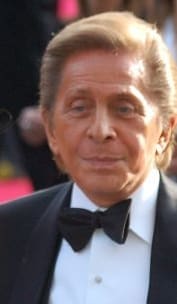
Italian fashion designer Valentino Garavani, whose work is renowned for its sophistication and romance, has died at the age of 83. Many famous people and socialites of the 1950s wore clothes he designed.
To set themselves apart from one another, each of these designers developed their own unique aesthetic. Chanel’s designs were simple yet timeless and elegant, while Dior’s New Look was feminine, elegant, and sophisticated. Balenciaga’s designs were sculptural and avant-garde, while Givenchy’s were classically elegant and would never go out of style. Balmain’s collections were known for their refined elegance, while Saint Laurent’s were lauded for their cutting-edge originality. Lacroix was known for his extravagant avant-garde designs, while Schiaparelli was known for her groundbreaking innovations in the fashion industry. Armani’s clothes were known for their sleek modernity, while Valentino’s were renowned for their elegant romance.



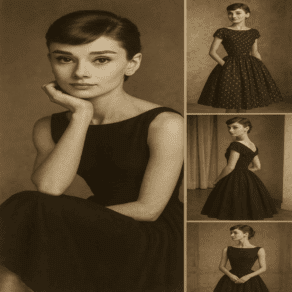


Leave a Comment